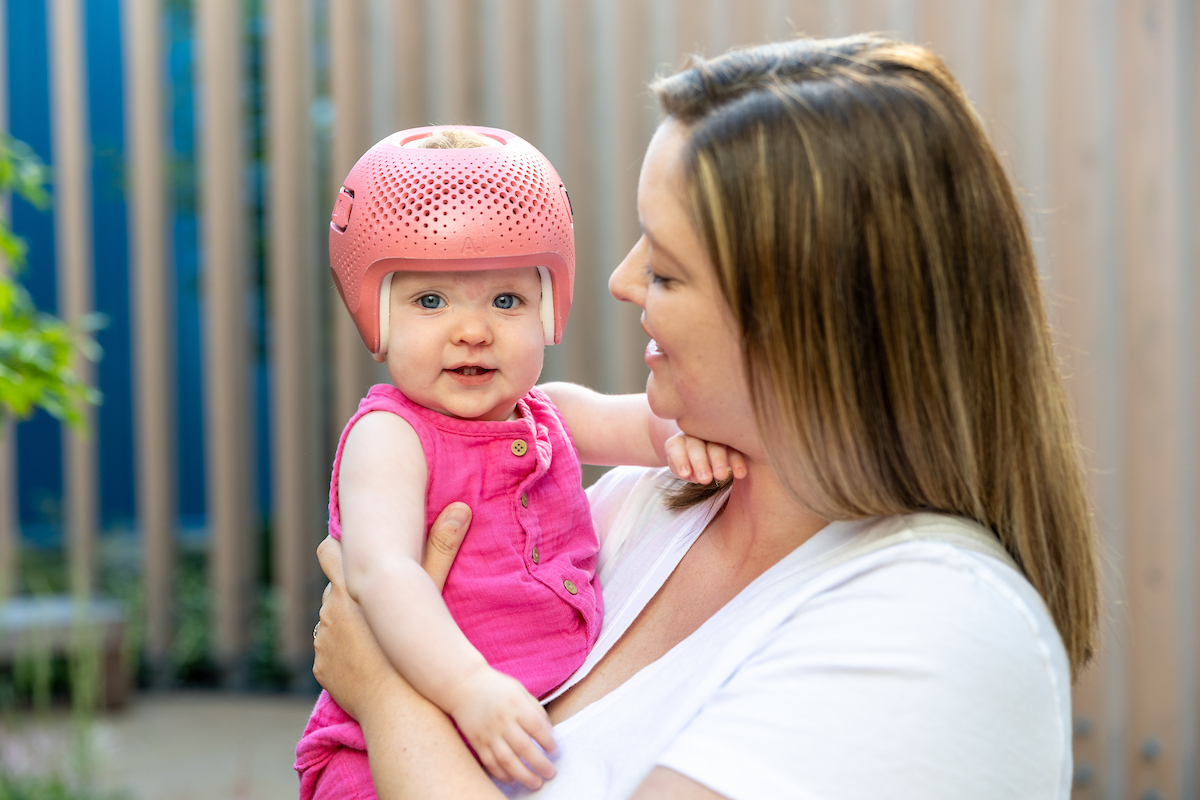What is a cranial remolding orthosis?
A cranial remolding orthosis is a baby helmet that corrects deformational plagiocephaly (also known as flat head syndrome). Plagiocephaly is a condition in which a baby’s head has an uneven or irregular shape caused by external forces.
Because the head might naturally rest on a slightly flattened area, positional plagiocephaly can worsen if untreated. Sometimes plagiocephaly corrects itself; however, it’s difficult to predict which infants will have plagiocephaly that corrects without treatment. At Gillette Children’s, you’ll get help determining if a cranial remolding orthosis (baby helmet) is an appropriate treatment for your child.
What sets Gillette apart in cranial remolding treatment and head shape correction?
Comprehensive plagiocephaly treatment from pediatric experts
Gillette excels in head shape treatment because we combine deep pediatric specialization, collaborative care, and cutting-edge tools to provide effective, family-centered care. Our teams are highly experienced in diagnosing and managing head shape differences that occur in infancy and early childhood. As part of your comprehensive plagiocephaly treatment plan, your family may choose to work with specialists in:
- Orthotics.
- Craniofacial and plastic surgery.
- Physical therapy.
- Child life.
Talee® by Invent Medical advanced 3D printed cranial orthosis
Gillette Children’s offers Talee® -- an advanced, 3D printed cranial remolding baby helmet.
Benefits of Talee helmets include:
2in1 Orthosis
Talee’s 2 stage treatment feature provides the controlled growth and improvement of 2 helmets in a single orthosis.
Unparalleled Comfort
Talee’s perforated structure makes the helmet thin and breathable, allowing ventilation which reduces sweating and skin issues.
Talee Reports
The report shows the treatment progress of your baby on a chart, in 2D cross-sections and on a 3D visualization.
Gillette Children’s offers Talee® -- an advanced, 3D printed cranial remolding baby helmet.
Benefits of Talee helmets include:
2in1 Orthosis
Talee’s 2 stage treatment feature provides the controlled growth and improvement of 2 helmets in a single orthosis.
Unparalleled Comfort
Talee’s perforated structure makes the helmet thin and breathable, allowing ventilation which reduces sweating and skin issues.
Talee Reports
The report shows the treatment progress of your baby on a chart, in 2D cross-sections and on a 3D visualization.
The best time for infants to begin wearing a cranial remolding baby helmet is when they are 4 to 6 months old. After a child is 12 months old, a baby helmet is less likely to change the shape of the head because most of the brain’s growth occurs during the first 13 months of life.
More than half of babies who have plagiocephaly also have a condition called torticollis. Gillette will help you coordinate additional services needed to treat associated conditions, such as physical therapy to treat torticollis.
Before your baby begins wearing a cranial remolding orthosis, they need an evaluation by a specialist. The process includes:
- Special technology (not an x-ray) that scans your child’s head to create a 3-D model on a computer. The scan doesn’t take long, but your infant’s head should be as still as possible. Your child may sit on your lap.
- Based on the model, our Orthotics, Prosthetics, and Seating experts will configure the baby helmet. You will choose the design.
- The baby helmet will be 3-D printed.
- A fitting for the helmet typically takes place two weeks after the scan.
How does baby helmeting help?
As your baby’s brain grows, the skull is slowly molded into the open areas of the baby helmet, rounding the head over time. It generally takes two to three months for this process to occur.
Once treatment begins, your child sees an orthotist one week after the initial helmet fitting and every two weeks for evaluation and adjustments.It’s important to continually monitor and adjust the cranial remolding baby helmet during the treatment process. Depending on the progress of the correction and the fit of the helmet, we’ll adjust it as needed. If the orthosis needs adjustment, we remove the helmet, heat it, and reshape it to accommodate new growth.
Your child gradually works up to wearing the baby helmet 23 hours a day to achieve the best possible results.
Medical insurance and billing questions
At Gillette Children’s, the cost of a cranial remolding baby helmet and weekly to biweekly management is part of a single charge. Insurance plans usually cover the services.
When you see a provider at one of our locations, your visit will show up on your bill as an “outpatient hospital facilities” appointment, rather than an “outpatient clinic” appointment. Insurance providers treat outpatient hospital facilities differently from outpatient clinics. You might have to make a larger copayment, pay a larger amount as a deductible, or pay a larger percentage of the cost of care than you would at a clinic that isn’t affiliated with a hospital. Be sure to ask your insurance provider or a Gillette financial specialist if this will affect you.
Check with your insurance carrier regarding coverage. If you have difficulty obtaining coverage for a cranial remolding orthosis or meeting obligations for copayments, Gillette Children’s has financing options available.
 Home Page
Home Page




